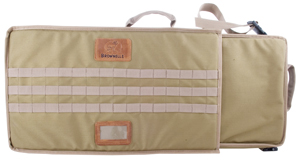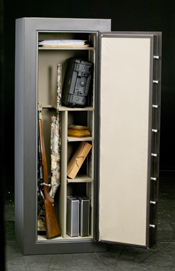
Gun cases are essential protection for transportation of firearms. Over the years I’ve stuffed rifles into home-made moosehide gun sleeves and $400 state-of-the-art polycarbonate shipping containers. I find that many shooters fail to realize how important cases are, so they buy an el cheapo and wonder why their rifles get rusted, dinged or even destroyed.
 There are three kinds of gun cases. First is the soft case used in the field. Second is the hard case necessary for shipping and airline travel. The third is the gun vault for long-term storage. Most hunters have at least one of these styles; if you have several firearms, you probably own all three. I use a variety of cases for my long guns and have learned a bit about what works and what does not.
There are three kinds of gun cases. First is the soft case used in the field. Second is the hard case necessary for shipping and airline travel. The third is the gun vault for long-term storage. Most hunters have at least one of these styles; if you have several firearms, you probably own all three. I use a variety of cases for my long guns and have learned a bit about what works and what does not.
Let’s start with soft cases. There are definite considerations when selecting a soft gun case.
My first concern is the shape of the case, as well as ensuring it is long enough to handle my rifles. For some stupid reason some manufacturers insist on designing their cases upside-down to my logic. I want my scope under the carrying handle of the case. Some designs require inserting the rifle scope-down; when you set the case down, the rifle rests on the scope turrets. I know it’s inside a case, but that isn’t a good idea. I also like the design to be roomy enough to handle rifles with Harris bipods attached.
Second consideration is the zipper. Cheap cases have cheap plastic zippers that have short lives. Nothing is more frustrating than having a zipper pop open or jam. Metal zippers or the heaviest plastic designs are essential.
Next I consider the material. Is it waterproof or will it hold moisture? The latest materials have a special impregnation that protects from rust and corrosion. Padding is obviously a consideration — the more the better. to a degree. Padding is not as essential as having a tough outer shell in my opinion.
 I bit the bullet many years ago and bought a pair of Filson gun cases that provide superb service. The money was well spent because those cases are as good as new despite a lot of rugged use. There are other good cases but I doubt any are better than the heavy canvas Filsons.
I bit the bullet many years ago and bought a pair of Filson gun cases that provide superb service. The money was well spent because those cases are as good as new despite a lot of rugged use. There are other good cases but I doubt any are better than the heavy canvas Filsons.
Hard cases are interesting because I’ve seen so many failures. I cannot understand why so many shooters are content to place $2,000 worth of rifle and scope into a $29 dollar plastic shell. One drop and the barrel is sticking through the end of the case. Good cases have good hinges, lockable hasps, adequate padding, and strong carrying handles.
I’ve learned there is also “good” polycarbonate and “not so good.” Not so good cracks and chips when dropped, particularly in cold weather. Good stuff dents and takes virtually any abuse. How do you know which is which? Usually spending good money will ensure top materials.
My favorite case doesn’t look like a gun case. I travel with a Tuffpack. The basic design is a five-sided shipping tube. Most people assume it contains golf clubs. The rifle is first put into a soft Filson case, then dropped into the Tuffpack and surrounded with clothes and other gear. This case locks securely and has wheels and a carrying handle. From Alaska to Africa, this case has done a perfect job of protecting my rifles and gear.
Anyone with a reasonable number of firearms and valuables should consider the purchase of a gun vault. I use my vault for much more than firearm storage, since it’s large enough (and hopefully fireproof enough) to protect valuable documents, cameras, and other goodies.
Again, there are considerations. Cost is a big one, as are size and design. Any vault or safe is better than none, but you usually get what we pay, for so consider the best quality you can afford. Don’t go with the bare minimum; you’ll appreciate size when you start putting rifles inside. Remember that scoped rifles take up more room — I figure about 1 ½ times what an un-scoped model requires.
Gun vaults range in weight from relatively light metal cabinets to 1,000-pound fireproof pieces of “furniture.”
There are essentially two types of locks: digital electronic keypads and traditional spindle wheels. Obviously hinges are important; some models have concealed hinges, others have exposed designs.
Another key consideration is the number of locking bolts and how they operate and are protected.
Some brands advertise virtual imperviousness to break-in, others cannot make that claim. Same goes for the fireproof rating. Fireproofing greatly increases the weight of the safe, but it’s worth having.
Gun cases are essential accessories. So take your time to research them to find the ones that best suit your needs.
— Sadly, Ian McMurchy passed away recently. His final “Trigger Time” columns will appear in every other issue of Gun Digest the Magazine. GDTM

![Best Concealed Carry Guns In 2025 [Field Tested] Wilson Combat EDC X9S 1](https://gundigest.com/wp-content/uploads/Wilson-Combat-EDC-X9S-1-324x160.jpg)


![Best 9mm Carbine: Affordable PCCs [Tested] Ruger Carbine Shooting](https://gundigest.com/wp-content/uploads/Ruger-Carbine-Shooting-100x70.jpg)
![Best AR-15: Top Options Available Today [Field Tested] Harrington and Richardson PSA XM177E2 feature](https://gundigest.com/wp-content/uploads/Harrington-and-Richardson-PSA-XM177E2-feature-100x70.jpg)
